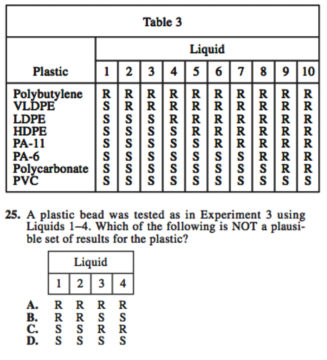When talking with students and parents about standardized testing, I am almost always asked about the notorious ACT science section. Negative experiences with biology or chemistry cause strong biases against it, and the realization that topics included are mainly those you’ve never seen exacerbate such sentiments.
I understand the hesitation: success on the ACT requires a delicate balance between precision and speed, and after 3 hours of rapidly inserting semicolons, computing products of matrices, and reading about a tattooed woman meditating on a beach, who could possibly look forward to answering questions about baryon quark spins and genetic epistasis at a rate faster than a question per minute?
Before you panic, let’s take a look at what is actually being tested. You might find that the ACT is a great option for you after all.
The ACT science portion is composed of 6-7 passages covering a range of different scientific topics. All passages but one are accompanied by a number of graphs, figures, and/or charts. You are asked to analyze the information and answer 5-7 questions that increase in difficulty as the test proceeds. Don’t freak out if a quick skim through a practice book or test makes it this section seem like deciphering hieroglyphics: electrostatics, magnetism, astronomy, and organic chemistry are all frequently appear.
Here is the great news. You actually need very little science knowledge to score well on this section.
Complex scientific phenomena do appear on the exams, but they almost never require more than a basic understanding of the principles you’ve known since middle school. Rather, the ACT Science section is tests your ability to interpret data and use deductive reasoning skills to reach a logical conclusion.
Check out a real ACT question: This is the second-to-last question (and therefore one of the most difficult) from a passage that compares the densities of Polybutylene, VLDPE, LDPE, HDPE, PA-11, PA-6, Polycarbonate, and PVC.
Say What???? Gibberish – I know. Hang in there with me as I break the question down for you.

This is – by far – one of the most common questions that students answer incorrectly because they get so lost in trying to comprehend a foreign concept that they forget what the question is asking.
If I were to erase all the words on the table and ask you “Which of these answers is impossible?”, all you’d have to do is compare the answers to the table. You’d see that you can find an example of every single answer in the table except for B. You can find A in the first row, C in the third row, and D in the last row. Therefore, B must be the answer. All you had to do was look for the answers in the table.
You don’t need any science to answer this question. It seems deceptively simple, even silly, for a question that is supposed to be one of the most difficult on the exam.
This question is a prime example of the methodology required to answer even the most difficult of questions: data analysis and common-sense whittle down possibilities until you’re left with one logical conclusion. Occasional questions appear that will be more difficult or require a consideration of multiple graphs/figures, but the vast majority of questions can be answered with a similar approach.
I’ve watched as students who literally have phobias of physics develop the ability to breeze through passages about kinematics and electrostatics and obtain perfect scores, equipped with nothing more than an understanding that gravity points down, that opposite charges attract, and the confidence that they can piece together the clues to solve the puzzle.
Therein lies the beauty of the ACT Science section. Though it is disguised by scientific jargon, this section requires nothing more than the adoption of a proper mindset and skill to conquer. And like any skill, you can master it!


